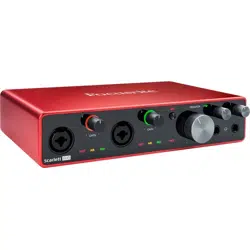Loading ...
Loading ...
Loading ...

17
If you are using a capacitor (condenser) microphone, press the 48V button to supply phantom power
to the mic. Most modern microphones of other types, e.g., dynamic or ribbon, will not be damaged
by the inadvertent application of phantom power, but note that some older mics may be; if you have
any doubt, please check the specification of your mic to ensure that it is safe to use.
Input channels 1 and 2 of the Scarlett 8i6 each have a PAD function: when selected from Focusrite
Control (PAD illuminates green when active), the signal level fed to your DAW is reduced by 10 dB.
You will find this useful if the output level of your source is particularly “hot”, when you might notice
clipping or the gain halo turning red, even at minimum gain.
Low Latency Monitoring
You will frequently hear the term “latency” used in connection with digital audio systems. In the
case of the simple DAW recording application described above, latency will be the time it takes for
your input signals to pass through your computer and audio software, and back out again via your
audio interface. While not an issue for most simple recording situations, under some circumstances,
latency can be a problem for a performer who wishes to record while monitoring their input signals.
This might be the case if you need to increase the size of your DAW’s recording buffer, which could
be necessary when you record overdubs on a particularly large project using many DAW tracks,
software instruments and FX plug-ins. Common symptoms of a buffer setting that is too low could
be glitching audio (clicks and pops), or a particularly high CPU load within your DAW (most DAWs
have a CPU load monitoring feature). Most DAWs will allow you to adjust buffer size from their Audio
Preferences* control page.
The Scarlett 8i6, in conjunction with Focusrite Control, allows zero latency monitoring, which
overcomes this problem. You can route your input signals directly to the Scarlett 8i6’s headphone and
line outputs. This enables the musicians to hear themselves with ultra-low latency – i.e., effectively
in “real time” – along with the computer playback. The input signals to the computer are not affected
in any way by this setting. However, note that any effects being added to the live instruments by
software plug-ins will not be heard in the headphones in this case, although the FX will still be
present on the recording.
When monitoring your inputs through Focusrite Control, ensure that your DAW software is not set
to route any inputs (what you are currently recording) to any outputs. If it is, the musicians will hear
themselves “twice”, with one signal audibly delayed as an echo.
* Typical name. Terminology may differ slightly between DAWs
Loading ...
Loading ...
Loading ...
